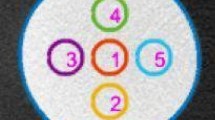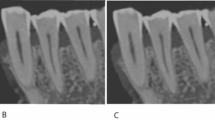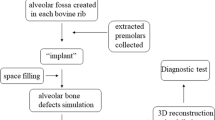Abstract
Objectives
The purpose of this study was to verify whether application of a quantitative computed tomography (QCT) technique was helpful for quantitative measurement of bone density using dental cone-beam CT (CBCT).
Methods
The left mandible of an opened-mouth head phantom was scanned with a dental CBCT machine at several tube voltages. A bone mineral contents phantom consisting of 20 blocks was used to provide the reference materials for the QCT technique. To investigate the effect of the number of reference materials used, three, four, or five blocks (reference blocks) were selected from the 20 blocks. The reference blocks were affixed to the surface of the lower jaw of the head phantom. Measurements of bone density were performed against another selected block (target block) set inside the oral cavity of the head phantom. The voxel values of the reference blocks and the target block on the obtained images were measured. The voxel values for the reference blocks were used to produce conversion curves. The density of the target block was calculated using each conversion curve.
Results
The conversion curves and voxel values of the target block were markedly and irregularly affected by the tube voltage and number of reference blocks. The error rates with three, four, and five reference blocks varied 4.1–11.0, 1.5–4.6, and 3.4–8.4 %, respectively.
Conclusions
Reference materials usage influences CBCT images in a non-uniform manner, and application of a QCT method does not aid quantitative measurement of bone density using dental CBCT.





Similar content being viewed by others
References
Scarfe WC, Farman AG. What is cone-beam CT and how does it work? Dent Clin N Am. 2008;52:707–30.
Kim DG. Can dental cone beam computed tomography assess bone mineral density? J Bone Metab. 2014;21:117–26.
Pauwels R, Jacobs R, Singer SR, Mupparapu M. CBCT-based bone quality assessment: are Hounsfield units applicable? Dentomaxillofac Radiol. 2015;44:20140238.
Mah P, Reeves TE, McDavid WD. Deriving Hounsfield units using grey levels in cone beam computed tomography. Dentomaxillofac Radiol. 2010;39:323–35.
Cann CE, Genant HK. Precise measurement of vertebral mineral content using computed tomography. J Comput Assist Tomogr. 1980;4:493–500.
Adams JE. Quantitative computed tomography. Eur J Radiol. 2009;71:415–24.
Aranyarachkul P, Caruso J, Gantes B, Schulz E, Riggs M, Dus I, et al. Bone density assessments of dental implant sites: 2. quantitative cone-beam computerized tomography. Int J Oral Maxillofac Implants. 2005;20:416–24.
Lagravère MO, Fang Y, Carey J, Toogood RW, Packota GV, Major PW. Density conversion factor determined using a cone-beam computed tomography unit NewTom QR-DVT 9000. Dentomaxillofac Radiol. 2006;35:407–40.
Naitoh M, Hirukawa A, Katsumata A, Ariji E. Evaluation of voxel values in mandibular cancellous bone: relationship between cone-beam computed tomography and multislice helical computed tomography. Clin Oral Implants Res. 2009;20:503–6.
Naitoh M, Hirukawa A, Katsumata A, Ariji E. Prospective study to estimate mandibular cancellous bone density using large-volume cone-beam computed tomography. Clin Oral Implants Res. 2010;21:1309–13.
Nomura Y, Watanabe H, Honda E, Kurabayashi T. Reliability of voxel values from cone-beam computed tomography for dental use in evaluating bone mineral density. Clin Oral Implants Res. 2010;21:558–62.
Araki K, Okano T. The effect of surrounding conditions on pixel value of cone beam computed tomography. Clin Oral Implants Res. 2013;24:862–5.
Bryant JA, Drage NA, Richmond S. Study of the scan uniformity from an i-CAT cone-beam CT dental imaging system. Dentomaxillofac Radiol. 2008;37:365–74.
Nackaerts O, Yan H, Souza PC, Pauwels R, Jacobs R. Analysis of intensity variability in multislice and cone beam computed tomography. Clin Oral Implants Res. 2011;22:873–9.
Naitoh M, Aimiya H, Nakata K, Gotoh K, Ariji E. Stability of voxel values in cone-beam computed tomography. Oral Radiol. 2014;30:147–52.
Nomura Y, Watanabe H, Kamiyama Y, Kurabayashi T. Physical quality evaluation of voxel values in cone-beam computed tomography for dental use: three-dimensional fluctuation of voxel values in uniform materials placed inside a phantom. Oral Radiol. 2014;30:2–226.
Parsa A, Ibrahim N, Hassan B, van der Stelt P, Wismeijer D. Influence of object location in cone beam computed tomography (NewTom 5G and 3D Accuitomo 170) on gray value measurements at an implant site. Oral Radiol. 2014;30:153–9.
Katsumata A, Hirukawa A, Okumura A, Naitoh M, Fujishita M, Ariji E, et al. Effects of image artifacts on gray-value density in limited-volume cone-beam computerized tomography. Oral Surg Oral Med Oral Pathol Oral Radiol Endod. 2007;104:829–36.
Conflict of interest
Keiichi Nishikawa, Yuuji Kousuge, and Tsukasa Sano declare that they have no conflict of interest.
Human and animal rights statements and informed consent
This article does not contain any studies with human or animal subjects performed by any of the authors.
Author information
Authors and Affiliations
Corresponding author
Rights and permissions
About this article
Cite this article
Nishikawa, K., Kousuge, Y. & Sano, T. Is application of a quantitative CT technique helpful for quantitative measurement of bone density using dental cone-beam CT?. Oral Radiol 32, 9–13 (2016). https://doi.org/10.1007/s11282-015-0202-z
Received:
Accepted:
Published:
Issue Date:
DOI: https://doi.org/10.1007/s11282-015-0202-z




